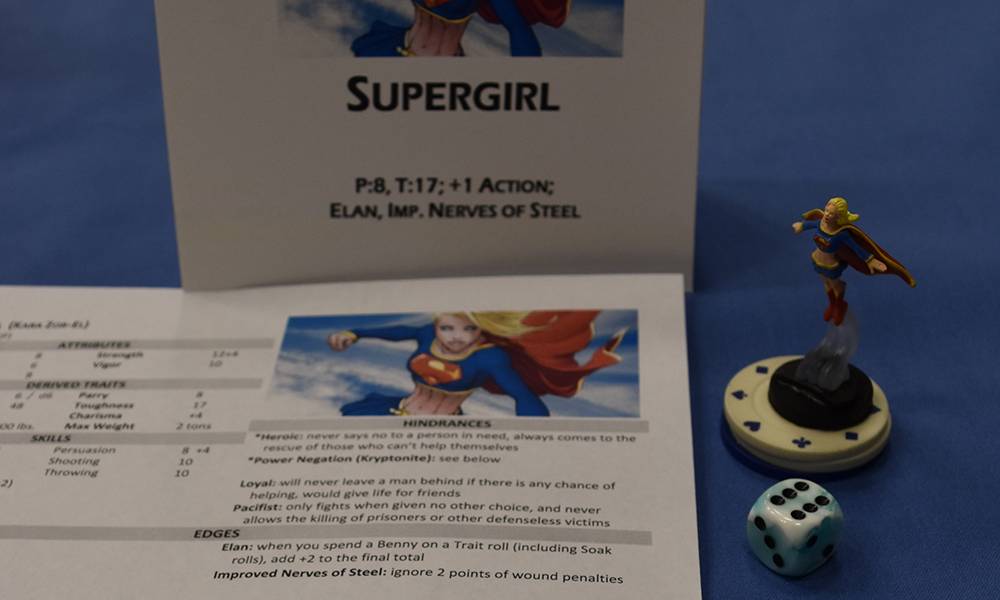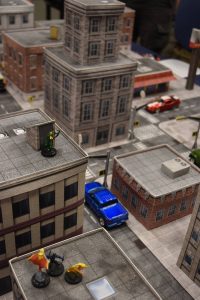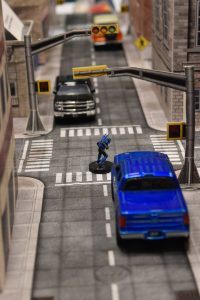
She really did have a momentary identity crisis when no one recognized the S.
Every year, I pour over the Origins event list to pick out the perfect combination of events to play. Well, at least that’s the goal. It’s actually a mix of equal parts careful choice and sheer luck, but it usually works out pretty okay. This year, I somehow signed up for back-to-back games that, based on the PCs and scenarios, were exactly alike. Both games involved joining up two tables of players; one was playing Marvel heroes while the other was playing DC heroes, with both groups trying to save their respective universes from the evil machinations of the exact same bad guys. It was a crossover collision!
How, you may ask, did I end up playing two games back-to-back that were almost identical? Isn’t that a pretty big failure of scheduling? Well, in my defense, one was labeled a bit more obscure than the other, but both involved GMs that I was looking to play with. I was only partially paying attention to the event descriptions. Both were obvious about being crossover games, though, and I really enjoy seeing GMs try something unique and epic with a con game. Games that intertwine two groups have always been a fascinating one for me.
I’ve actually written about turning game night into an event before. Sometimes there are just things you want to try out as a GM that wouldn’t work in a regular campaign. Twice, myself and a friend have attempted a crossover event game. For the first one, we had two rival adventuring parties going after the same MacGuffin that just happened to be hidden in the lair of a blue dragon. The players actually spent more time trying to pick each other off than dealing with the dragon, but overall the game was a success. It did teach me that even the hint of PVP can change the way players react to certain situations. The other attempt was less successful, but that was partially because both of us GMs were uncertain of the system we were running and it slowed the game down a little too much. I wish we had been better prepared, because I was very intrigued by the scenario: alternate universe versions of the same adventuring party get mixed together as they simultaneously fight to repair a tear in the veil between worlds. Someday I may try and make it work again, but I learned how prepared we need to be to make it work.
So, back to Origins. The first game, Savage World Supers, was run by Dave Russo and Mike Whiteman of Amorphous Blob Games. Like many Savage GMs, they brought a dramatic touch of theatricality to the game with an amazing cityscape set up for the final battle. Dave Russo earned a place on my ‘Awesome GMs List’ several years back at Origins when he ran a Savage Worlds Bureau 13 game that turned out to be a huge homage to Big Trouble in Little China.
In this particular game, I ended up playing as Supergirl while she and several other DC heroes investigated a strange explosion at Star Labs. While most of the DC characters were well known, they weren’t the A-listers from the DC universe. In the middle of fighting some villains none of our characters recognized (because they were Marvel D-listers), the lab suddenly turned into a Stark Industries Lab. Poor Supergirl had a momentary identity crisis when no one seemed to know who she was or recognize the big S on her chest. At a climactic moment, another pulse of light hit and everyone was transported to a city that was a mishmash of many cities overlaid on top of one another. There were a few moments of PVP between our second string Justice Leaguers and an eclectic group of Avengers squaring off, each thinking the other group was responsible for the mess. Hawkeye and Green Arrow took special pleasure in trying to out-shoot one another. Very quickly, we realized that Braniac and Ultron were the real culprits and all the heroes started working together.
Everyone at both tables was a great sport and really got into the whole thing. Names kept getting mixed up, with Captain America (being played by a gentleman with a British accent) was referred to as Flag Man, Blue Beetle was dubbed Cobalt Cockroach, and poor Supergirl was referred to as S-Girl.
All in all, it was a fun game with a focus on tactical play, which is often true for a Savage Worlds game. The roleplaying was fun, but the focus was on the spectacular city the GMs had put together and using that environment in our favor against the villains.
Later that evening, the game was a team-up between Ed Rollins of Matinee Adventures and Jason Altland of Crimson Hand Gamers, both great GMs and groups. They were using Mutants and Masterminds and had a full collection of A-listers from both Justice League and the Avengers. Ed and Jason also ran a crossover game last year with The Dresden Files, so I had every confidence they were going to provide a good game.
This time, I was at the Avengers table and chose Scarlet Witch as my character. The moment weird stuff started happening with reality, everyone looked at her accusingly. I kept having to repeat, “It’s not my fault this time! At least, I don’t think it is.” In this version of the scenario, the Avengers ended up clearly in the DC universe. They had a run in with some obscure super powered punks, but also got to meet with a very congenial and convincing Lex Luthor. Iron Man thought he’d met a kindred spirit. We found out that the JLA table met a very arrogant Victor von Doom who they pretty much started beating on right away. How could he be a good guy with a name like that?
When the game hit the climactic moment and both universes hung in the balance, all the heroes were transported to a strange blend of the Neutral Zone and the Negative Zone. Just as in the previous game, it turned out that the muddled realities were the fault of Ultron and Braniac teaming up, but this time it was quite literal as they merged into one very big bad. Just like how it works in the comics, the heroes all threw themselves at the bad guys individually until finally the idea to fight together clicked in. Iron Man worked with Wonder Woman to amplify his blasts off her bracelets, and then the final blow was struck by Superman wielding Mjolnir, thrown to him willingly by Thor since Superman was in a better position to make the attack.
In comparison to the earlier game, this one was all theater of the mind. While it was still a very tactical game in the way we used our powers, it relied a bit more on roleplaying and interacting with the mixed realities. Just like the other game, though, I had an absolute blast. During the last battle, there were a couple of players hanging back and not quite getting into the spirit of the team-up, but it was also an evening game, so it was the end of a long day for everyone.
Some people might have been disappointed that the two games were so similar, but I found it to be a unique opportunity to take a look at the differences that GM play style, system, and the other players at the table all bring to a game. Even though they had similar concepts and used the exact same ultimate bad guys, they were still very different games. It’s honestly very cool to see GMs collaborating to try and pull together something epic in scale for their players at a convention like that.
While I definitely prefer my smaller games for campaigns, I hope to try and work on some collaborations of my own in the future. It takes a bit more logistical work and a high level of cooperation between GMs, but it can be a nice way to turn an event game into something special.
Have you ever had a chance to play in or run your very own crossover collision?























Are you referring to setting crossovers, or table crossovers, or both? I’ve played and ran a few of the latter, all at Origins.
The one that I’ve played had two tables that met in the middle of the game, and were expected to team up. Due to a variety of factors, my table totally mistrusted the other table and we only followed them to watch the showdown fight (at the pleading of the GM). The GM lesson here should be to know your setting(s), since the information we received was that we shouldn’t expect any help, so we didn’t believe it when the other table showed up– it screamed “TRAP!” It did lead to a long, intense, and very enjoyable discussion among some players from both tables in the hallway afterwards, though.
I’ve participated in running two games that brought separate groups together in head-to-head fights. These went pretty well, as we were able to fill two tables. Each time, one side was leading squads of mooks, while the other were elite PCs, able to create lots of individual firepower. This led to heavy casualties on the more-numerous side, and limited ones on the other, all of which was expected and accepted in a one-shot convention game. The major snag in this year’s game was that while we had agreed to merge the tables after an hour, the other table was still in a fight well over an hour after mine was ready, and so we played some ad-hoc banter while waiting for the signal to come in. A lesson there should be that both GMs need to be prepared to alter things as needed, I needed more to do on my side (which I readily admit to), and the other guy needed less. Playtesting may be even more important when two tables’ fun is on the line?
Mostly table crossovers. It just happened that these two games both involved setting crossovers.
Yeah, one of the things I’ve found with table crossover games is you have to be fairly up front about the goals. In the Dresden Files crossover, the black hats and white hats had to work together to fix the potentially universe destroying problem, but well over half the PCs were completely focused on PVP. Luckily a couple of us were able to work together in the middle of the battle to fix the problem, but it showed that PVP had to be handled carefully or purposefully.
And you are absolutely right. Timing is one of the very important factors I should have mentioned above. Both tables need to reach the tipping point for the crossover right about the same time.
So this isn’t TOTALLY off subject, but it MOSTLY is…
This article reminded me of a campaign I started about a year ago with my play group. I had four players and had each player create alternate versions of each of the three OTHER players character’s. The new character needed only to share the name, race, and sex of the “original” character. I would then mix and match the new characters to make three alternate reality parties.
The campaign idea was to run sessions with each different party at different times, and grade them. Then the WORST party would go up against the Big Bad, who was a dimensional shifter, looking for the “best” world to take over, based on the strength (or lack thereof) of the heroes he faced.
Everyone thought it was a cool idea, but when it came to playing an alternate version of your own lovingly crafted character – that someone else created – my players didn’t share my enthusiasm, and the campaign tanked half way the third session.
Have you tried anything like this? If so, did you have better results than I did??
Sorry to go so far off track, but I had completely forgotten about that campaign until I read your article.
Thanks!
That is a neat idea, but I can totally see you running into problems with the players having to play different versions of their characters. It might have worked better if you’d had them each make the alternate versions, but have to take suggestions or guidance from other players for the differences. This way they could have some investment in the characters as they dimension hop.
(When I did the alternate reality versions of the same character, I did have a male/female swap on one character. In the male’s reality, he had fought his way free of slavery by being a gladiator and was quite a bit of a chauvinist pig for a variety of reasons. In the female’s reality, she had also been a slave, but had murdered her owner and escaped into the night. The two of them having to face the ‘what if’ of each other could have been interesting but didn’t play out because of our fumbling of the system.)
The closest I ever did to what you’re talking about was when I was running a supers game and a player’s character jumped through a portal after a bad guy, but it closed before anyone else could get through. I basically staged a one shot where all the other players played different reality versions of their character suddenly facing this version of their friend/brother that had died. That actually turned out really well, but the players only had to play that alt version of their character once.
Yeah looking back I would have definitely had each player make their own alternates!
I thought it would be cool to be able to play the same character differently every time, so no-one would get bored with their character. It turned out to be too much work for them LOL.
The only player who REALLY enjoyed it was a part-time actor at a local Murder Mystery Dinner Show. He loved the idea of being able to constantly redefine his character and did some really cool things with his presentation of the different aspects of his character. His “main” character was a strong, military type, which he played appropriately strong. An alternate was a man with a terrible step father (who he didn’t have in the main timeline) that introduced him to drugs. It was really fun to see him play the same person in totally different ways! Alas he missed the third session (when the campaign tanked) and I never got to see his other personas.
So the 2 things I got out of it was 1) Each player needs to be able to make their alternates and 2) You have to have players that REALLY want to do this kind of thing. Right now I don’t have that kind of player.
Thanks for your feedback and listening to me ramble LOL
I know there have been a bunch of crossover games over the years at Ambercon. (In the sense you mean, Ambercon also has a single game “crossover” notion where the PCs are crossing over from multiple different versions of the Amber multiverse.)
Particularly memorable: Back in the late 90s, someone ran a “Sliders” game which spent most (all?) of its slot sliding into other games. I believe the GM did check ahead with the other GMs for permission, but I don’t think there was any detailed planning involved. How well it worked for the games slid into seems to have varied — some people praise it to this day, some people grumble loudly if it is mentioned.
I ran a crossover with Rain Donaldson where we had two independent games (with little to no coordination), but the players crossed over between the games. We ran in adjoining rooms and would just send the players to the other room as needed. It’s actually been long enough I’ve forgotten most of the details, but I think it was fairly well received.
Recently, Kit Kindred has had parallel games going on for three years running. Again, adjoining rooms, with two or three different GMs and corresponding groups of players, each group on a different mission but at the same time in the same (Lords of Gossamer and Shadow) multiverse, with the potential for characters to interact if needed. I know the first year one of the players on our team ended up spending a lot of time with the other group; this year our group actually had fallen out of the multiverse and so was not in any position to interact at all.
That’s pretty cool. I only have a limited experience with Amber, but I’ve always been a very big fan of ‘multiverse theory’ and the stories that can result from that. 🙂